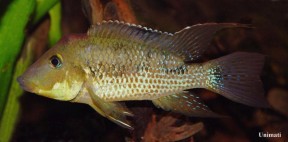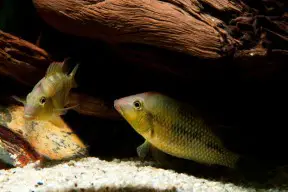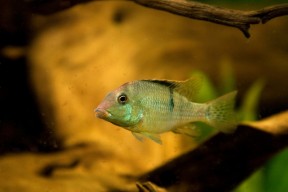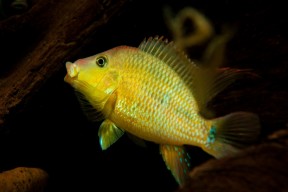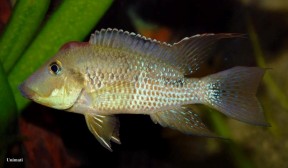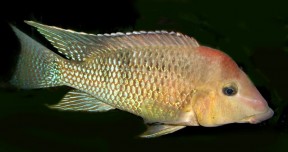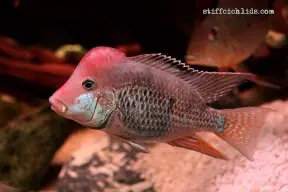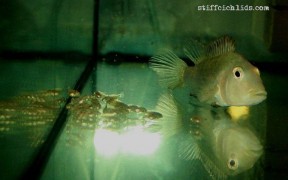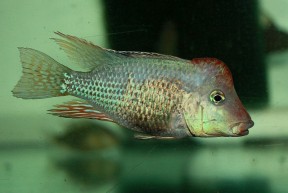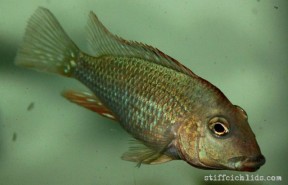'Geophagus' steindachneri
Red Hump Eartheater
SynonymsTop ↑
Geophagus hondae Regan, 1912, Geophagus magdalena Brind, 1943
Etymology
Geophagus: from the Ancient Greek γῆ (gê), meaning ‘earth’, and φαγεῖν (phageîn), meaning ‘to eat’.
steindachneri: named for Austrian zoologist Franz Steindachner.
Classification
Order: Perciformes Family: Cichlidae
Distribution
Widespread throughout the Río Magdalena drainage, Colombia, including its major tributary the Río Cauca, plus the Río Sinú drainage in northwestern Colombia and Río Limón basin, northwestern Venezuela. The latter drains into Lago de Maracaibo (Lake Maracaibo) close to the Caribbean Sea.
Type locality is given simply as ‘Colombia’.
Habitat
Occurs in various habitats, but appears to prefer forested streams, tributaries, and backwaters with sandy substrates.
Maximum Standard Length
Male 130 – 150 mm; female 110 – 130 mm.
Aquarium SizeTop ↑
Minimum base dimensions of 120 ∗ 45 cm or equivalent are required.
Maintenance
The most essential item of décor is a soft, sandy substrate so that the fish can browse naturally (see ‘Diet’). Coarser materials such as gravel or small pebbles can inhibit feeding, damage gill filaments and even be ingested with the potential of internal damage or blockages.
Additional furnishings are as much a case of personal taste as anything else but the most favoured set-ups tend to feature relatively dim lighting plus some chunks of driftwood and scattered roots or branches. One or two flattish, water-worn rocks can also be included to provide potential spawning sites.
Leaf litter is a typical feature of the natural environment but not really recommended in aquaria because this species’ feeding behaviour tends to cause an excess of partially-decomposed material in suspension which not only looks unsightly but can block filter and pump mechanisms.
Water quality is of the utmost importance since these cichlids are susceptible to deteriorating water quality, and should never be introduced to a biologically immature aquarium. Minimum weekly water changes of 40-70% are suggested, while mechanical filtration should be tailored to trap small particles stirred up by the fish since sand can cause blockages and wearing issues with filter mechanisms if allowed to continually run through the system.
Water Conditions
Temperature: 20 – 30 °C
pH: 6.0 – 7.5
Hardness: 36 – 215 ppm
Diet
Benthophagous by nature, mostly employing a feeding strategy whereby mouthfuls of substrate are taken and sifted for edible items with the remaining material expelled via the gills and mouth. Once settled it will readily rise into the water column when food is introduced but continue to browse normally at other times.
The stomach contents of wild specimens mostly comprise small aquatic and terrestrial invertebrates, plant material in the form of seeds, organic detritus and sediment. Even as adults these cichlids seem unable to properly ingest larger food items meaning the diet should contain a variety of high quality, fine-grade prepared foods plus small live or frozen chironomid larvae (bloodworm), Tubifex, Artemia, mosquito larvae, etc.
Home-made, gelatine-bound recipes containing a mixture of dried fish food, puréed shellfish, fresh fruit and vegetables, for example, are proven to work well and can be cut into bite-sized discs using the end of a sharp pipette or small knife. Rather than a single large meal offer 3-4 smaller portions daily to allow natural browsing behaviour, since this seems to result in the best growth rate and condition.
Behaviour and CompatibilityTop ↑
Adult males are aggressively territorial towards rival males, especially when reproductively active, and only a single individual should be housed in all but the largest aquaria. It is best to provide the male with three or more females in order to disperse aggression should the male come into breeding condition.
Ideal tankmates include pelagic characins, with aggressive or territorial benthic species best avoided.
Sexual Dimorphism
Adult males are larger in size and have longer unpaired fin lobes than females. Sexually mature males develop a nuchal hump which can be very pronounced in some individuals.
Reproduction
Ovophilous, maternal mouthbrooder forming weak temporary pair bonds for the duration of the spawning process, after which the female is responsible for broodcare. Males are polygamous and may breed with several females during the reproductive period.
Courtship is initiated by the male, and may last for several hours. When the ovipositor is fully extended, the female begins to lay small batches of eggs on a hard surface within the territory of the male. Each batch of eggs is collected in the mouth of the female before the male releases milt directly in front of her mouth in order to fertilise them. Once spawning is complete most breeders prefer to remove the brooding female to a separate aquarium.
The female incubates the eggs for 10-14 days, but the fry may return to her mouth for a further week or more once they are free swimming. The fry are easily-fed, accepting Artemia nauplii, microworm, etc.
NotesTop ↑
This species lends its name to the ‘G.‘ steindachneri group, an assemblage of closely-related species with unresolved taxonomic placement which currently also includes ‘G.‘ crassilabris and ‘G.‘ pellegrini.
It exists in a number of colour forms which vary with locality, some of which may eventually be described as separate taxa. Some of these may appear on trade lists under the synonym Geophagus hondae.
The genus Geophagus was rediagnosed by Kullander (1986) who restricted it to include only those species with paired caudal extensions to the swimbladder lined by 6-12 epihemal ribs plus a greater number of caudal than abdominal vertebrae. Some former species were moved into the revalidated genus Satanoperca while others, such as the ‘Geophagus‘ brasiliensis and ‘G.‘ steindachneri groups, represent distinct lineages still in need of definitive classification.
‘Geophagus‘ and a number of related genera are often included in the putative subfamily Geophaginae which Kullander (1998) considered to contain 16 genera divided among three ‘tribes’:
Acarichthyini – Acarichthys and Guianacara.
Crenicaratini – Biotoecus, Crenicara, Dicrossus and Mazarunia.
Geophagini – Geophagus, Mikrogeophagus, ‘Geophagus‘ brasiliensis group, ‘Geophagus‘ steindachneri group, Gymnogeophagus, Satanoperca, Biotodoma, Apistogramma, Apistogrammoides and Taeniacara.
Later molecular studies by Farias et al. (1999, 2000, 2001) resulted in the additions of Crenicichla and Teleocichla to the Geophaginae, a result supported by López-Fernández et al. (2005) who conducted the most detailed molecular analysis of the grouping to date including 16 of the 18 genera and 30 species.
Their conclusions regarding interrelationships between genera did vary somewhat from previous hypotheses and can be summarised by the following loosely-defined groups:
– a weakly-supported sister group relationship between Acarichthys and Guianacara.
– a well-supported “Satanoperca clade” comprising Satanoperca, Apistogramma, Apistogrammoides and Taeniacara.
– a “big clade” with Geophagus, Mikrogeophagus, ‘Geophagus‘ brasiliensis group, ‘Geophagus‘ steindachneri group, Gymnogeophagus, Biotodoma, Crenicara and Dicrossus.
– a “crenicarine clade” with Biotoecus and Crenicichla.
No representatives of Teleocichla or Mazarunia were included in the study but the former is well-established as sister to Crenicichla while the latter has grouped closely with Dicrossus and Crenicara in earlier works.
The other main conclusions of the paper are confirmation that Geophaginae is a monophyletic group exhibiting strong signs of having undergone rapid adaptive radiation (diversification of a species or single ancestral type into several forms that are each adaptively specialised to a specific environmental niche).
References
- Eigenmann, C. H., 1922 - Memoirs of the Carnegie Museum 9(1): 1-346
The fishes of western South America, Part I. The fresh-water fishes of northwestern South America, including Colombia, Panama, and the Pacific slopes of Ecuador and Peru, together with an appendix upon the fishes of the Rio Meta in Colombia. - Farias, I. P., G. Ortí and A. Meyer, 2000 - The Journal of Experimental Zoology 288(1): 76-92
Total evidence: molecules, morphology, and the phylogenetics of cichlid fishes. - Farias, I. P., G. Ortí, I. Sampaio, H. Schneider and A. Meyer, 1999 - Journal of Molecular Evolution 48(6): 703-711
Mitochondrial DNA phylogeny of the family Cichlidae: monophyly and fast molecular evolution of the Neotropical assemblage. - Farias, I. P., G. Ortí, I. Sampaio, H. Schneider and A. Meyer, 2001 - Journal of Molecular Evolution 53(2): 89-103
The cytrochrome b gene as a phylogenetic marker: the limits of resolution for analyzing relationships among cichlid fishes. - López-Fernández, H., R. L. Honeycutt, M. L. J. Stiassny and K. O. Winemiller, 2005 - Zoologica Scripta 34(6): 627-651
Morphology, molecules, and character congruence in the phylogeny of South American geophagine cichlids (Perciformes, Labroidei). - Newman, L., 1993 - Cichlid News Magazine 2(4): Available online at: http://www.aquarticles.com/articles/breeding/Newman_Red_Hump.html
Maintenance And Breeding Of The Red Hump Eartheater, Geophagus steindachneri Eigenmann And Hildebrand 1910. - Reis, R. E., S. O. Kullander and C. J. Ferraris, Jr. (eds), 2003 - EDIPUCRS, Porto Alegre: i-xi + 1-729
Checklist of the Freshwater Fishes of South and Central America. CLOFFSCA.
